

603. $10
Westclox “La Salle Dura Case 61-F”, 1930-1934. One of six alarm clocks in the La Salle Dura
case series, each in a heavy metal case with nickel plating and art deco dials. This one is just over 3 inches tall with a good
finish and dial. It is not running. $25-$50.

604. $1500
Southern Calendar Clock Co. “Fashion No. 6”, ca. 1877. The No. 6 Fashion is distinguished
by its painted black dials with gold lettering, nickel-plated “Fashion” hands, and a long-drop damascened pendulum. This clock
meets all the criteria except the hands, which are silver-painted Fashion hands (the calendar hand is sanded down to bare metal). The signed Seth Thomas movement is mounted on an iron frame; the wire gong is dated, and the dials have the correct and expected patent
dates and labeling “Made by Seth Thomas Clock Co”. The solid walnut case is in excellent shape, with good replacement finials. The door glass is replaced and the Fashion lettering repainted. There is a nice Southern Calendar Clock Co label on the back. The clock is running, keeping time, striking on cue, and the calendar is advancing. We sold a No. 6 in January 2017 for $3380,
but it was practically perfect; one in lesser condition sold in May 2016 for $3085. $1800-$3000.

605. $1000
Seth Thomas “Regulator No. 18”. A flawless 54-inch oak case in a golden oak finish, probably
made in the last 50 years and signed at the top “M.L.”. The dial pan is also new. The hands, including the seconds hand
appear to be old Seth Thomas issue, as is the signed movement and weight. The pendulum stick may be old, the bob is new. Both glasses are wavy, and there is a replacement label in the bottom. Running, 8-days, time only, and keeping time. It’s
hard to fault someone who can take an old movement and restore it into a case that looks this good. We sold an original in 2016
for $2550. $1250-$1800.
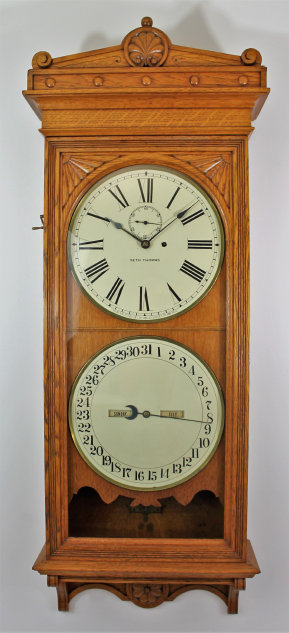
606. $1500
Seth Thomas Office Calendar No. 13, ca. 1890. An original issue, 49-inch double-dial calendar clock
in refinished oak, repainted original dials, original hands, old glass in the door, and recovered calendar rollers. The time-only,
8-day, unsigned weight-driven movement is running, keeping time and the calendar date and day indicators are advancing. The
damascened brass pendulum bob and stick are original; the gold-painted weight is correct. The case is about perfect. The
only thing I can find to complain about is the calendar dial, which could have been numbered a bit more sharply. You won’t notice
that unless you press your nose to the glass. Big, heavy, and impressive. We sold an original oak No. 13 in January of
2015 for $3000; Schmitt’s sold a refinished oak original in 2008 for $4750. $2000-$3000.
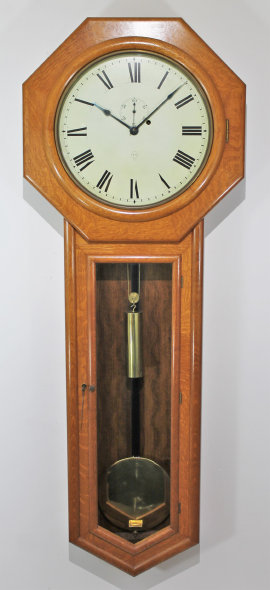
607. $75
Telechron Model 8B02, “The Executive”, 1932-1938. Another early digital clock using rollers
to show the time; there is a large disk that rotates to show the seconds in the arched window below the hour and minute windows. The front plate is engraved brass with a GE symbol at the top. The 6.25-inch high brown Bakelite case is in good shape, with
the following caveats: Two small corners are missing on the back plate, with a larger corner piece broken but in place; part
of one hinge on the top piece that swings up to allow you to adjust the time is missing, but the top still flips up and stays in place,
open or closed. There is a lever on the back that you press to reset the red flag in front that alerts you that the power has
failed (between the hour and minute windows). The clock is running fast, by about 30 min/day. These guys sell on eBay
for about $150. $100-$150.
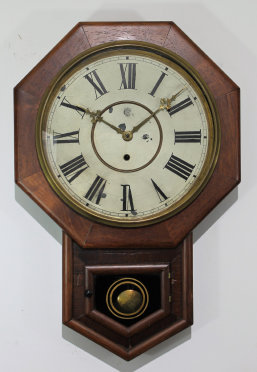
608. $25
Waterbury “Drop Octagon”, 1891. A 24-inch case veneered in rosewood with just a few chips. The
dial glass is newer, the bottom glass possibly original, with old or original paint as show in the catalog illustration. The
12-inch metal dial has the original paint, with the Waterbury logo and just a bit of chipping; some of the numerals have been retouched. The brass hands are nice. The signed 8-day time-only movement is running strongly. A black and gold label inside, with
significant losses. $50-$100.
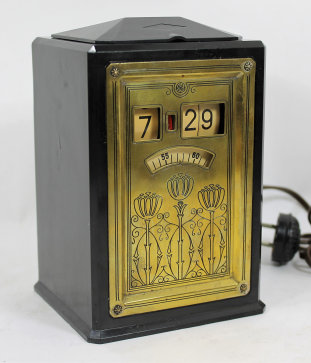
609. $100
Ansonia “Comet”, 1904. This is a large carriage clock, 6.5 inches tall with the handle down. The finish is silver, with some wear and tarnish. Beveled glass in front over a 3-inch dial with an alarm dial. The movement
is signed in back but we can’t convince it to run. It’s a one-day that strikes on a bell underneath on the hour and half-hour. A couple of recent sales on eBay for about $125.

610. $10
United Clock Co “Lucky” and Lanshire horseshoe. A chrome horseshoe on a stepped wooden base
holding an electric clock, marked “Lucky” at the top of the horseshoe. The stamped manufacture date inside is 1949. The
cord and plug are new; the clock is running and keeping time, 9 inches tall and 9.5 inches wide. Lanshire Horseshoe Model T3
electric shelf clock, ca. 1947. A bronze base, 7 inches high and 6 inches wide with two horses in a fenced pasture below the
dial inside an inverted horseshoe. The dial says “Self Starting” with “Clock movement by Lanshire Chicago USA” along the bottom. Typical wear to case, with some corrosion of brass bezel. Clock is running. $25-$50.
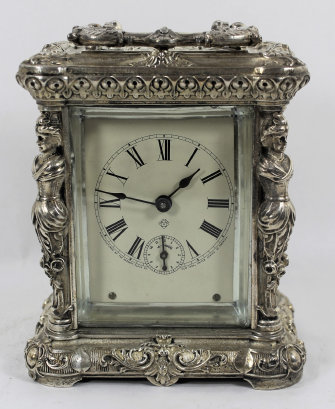
611. $75
Etalage Reclame Corp. “Prins”, ca. 1948. Leendert Prins patented the first “mystery clock” where the single glass dial rotates
with an attached hand assembly; this patent was later bought by Jefferson Electric Co. and led to the many “Golden” mystery clocks
you can now find on eBay and, occasionally, here. This was the first model. It appears they were all made at this
location in New York and marketed under various names by different companies. It stands on an oak base that houses the electric
motor made by Haydon Mfg. Co. which drives the glass dial through one full rotation every hour. There is a gear ring on the
glass hidden by the gold-plated bezel. The clock stands 10-inches tall and is a bit top-heavy; the bezel is also a bit loose
on its stand, but probably could be tightened up if you wish to remove the motor. The clock is running and keeping time, but
a bit noisy, and the glass is loose in the bezel. The power cord is original, as are all the parts. The gold-plated bezel
and hands show considerable wear, corrosion and oxidation, and some of the finish has been polished off. I have seen only two
of these clocks, they are not common. But this is the original “mystery clock”; one sold on eBay in March 2017 for $237. You can find out more about these clocks on Roger Russell’s website. $125-$250.
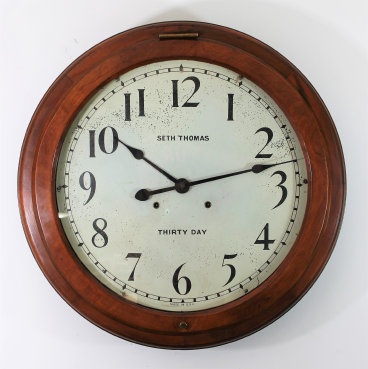
612. $300
Seth Thomas “Arcade No. 1”, ca. 1913. This gallery clock is 23 inches across with an
18-inch dial; it is the smallest model Arcade. The case looks like cherry, but the book says it came in “mahogany finish and
old oak”. The dial is clean with the original paint, but lots of fleck-sized losses. The hands are appropriate but not
correct to this model. The bezel opens from the top and holds a new glass. The 30-day signed double-spring movement has
a Graham dead-beat escapement and is running and keeping time, with a large, heavy nickel pendulum bob. I don’t see a label. Not so big as to be overwhelming; this clock would fit nicely on a lot of walls. Prices are variable with this clock, starting
at $400 at Schmitt’s in 2015. $400-$750.
